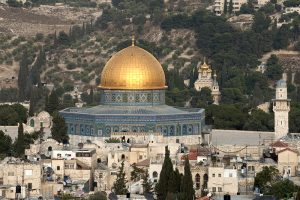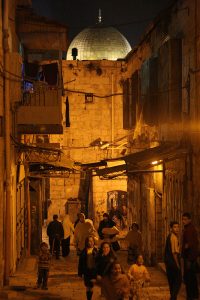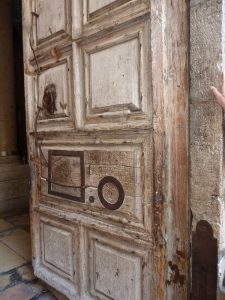My Friend and Neighbor*
My friend and neighbor, Ahmed, is a pious Muslim. He prays daily, and he goes regularly to the Aqsa Mosque for Friday prayers to be with the thousands of others who come from all over Jerusalem and Palestine. With this neighbor and friend, I always feel that there are no Christian, Muslim, Jewish, or Armenian quarters in the Old City, for he always gives me the feeling that Jerusalem is one, belonging to all who want to live in it as good neighbors. Ahmed prides himself, like I do, on the fact that he educated his children, both girls and boys, in the best of the “Christian” private schools, and there is a score of these for boys and girls within and around the Old City. His children and mine became friends at school; they played basketball and volleyball together and frequented the same youth clubs. They took part together in the folkloric dance groups, choirs, and other musical events of their schools. They, the children, invited each other to their birthday celebrations and other happy occasions. After school, they often shared the culinary delights that are found in popular restaurants in the streets of the Old City. Not that they did not like the food or sweets prepared by their mothers, but the spirit of companionship, humor, and togetherness won over. When it was time for them to enter the “marriage cage,” they consulted with each other on the best practices to follow and shared their experiences. They also intensely discussed which careers to follow and which universities to go to for further professional advancement.

Jerusalem is not simply the holy shrines of the various religious traditions; it is the people who make the city what it is. A visitor, whether tourist or pilgrim, usually misses the complexity of the relationships across quarters as she/he never shares the living experiences of people like Ahmed. With limited time and a heavy itinerary of visits to holy and unholy places, the visitor may find it more expedient to rely on generalizations and stereotypes. The tourist guide, whether local or international, becomes the coach who offers an understanding, albeit flawed, of the city and its various communities.
The Old City of Jerusalem has always prided itself on the very good relations that particularly brought together its different inhabitants. At a certain time, the “old” Muslim families of Jerusalem developed special relationships with the various Christian and Jewish communities. Like the Christians who originally resided near the Holy Sepulcher and other holy places in the Old City, hence, the Christian Quarter, the “elite” Muslim families originally lived close to Al-Haram al-Sharif compound and with them hundreds of other Muslim families, hence, the Muslim Quarter. The higher the status of a family, the closer it lived to the compound. Near the Western Wall, Jews chose to make their residence for the expediency of worship and reverence, hence, the Jewish Quarter. The Armenians, with their church founded in Armenia in 301, have had a presence in the city since the fifth century. By the early fourteenth century, the Armenian Quarter was well established on Jerusalem’s maps. I am much impressed with the narrative of Khalil Sakakini, a Palestinian Christian educator prior to 1948, when he related how he had hid Jews at his home during the First World War when the Ottoman authorities sought to jail them. But Khalil, like the rest of us Palestinians, became despondent with the developments and eventual dispossession wrought on our people by the insistence of Zionists to create an exclusive state on our lands.

Photo courtesy of jerusalemexperience.com
Ahmed keeps reminding me that in the earlier part of the twentieth century it was customary for Christians of the city to take part in cleaning the Aqsa Mosque and the Dome of the Rock. It was a privilege that symbolized interreligious openness and communal togetherness. I remind Ahmed of the fact that the keys to the Holy Sepulcher are in the hands of an “old elite” Muslim family of Jerusalem who has been entrusted with opening and closing the church by the thirteen Christian heads of churches that are present in Jerusalem.
I remember as a child the great fire at the Holy Sepulcher that took place in the late forties, in 1949 to be exact, when Muslim and Christian merchants and nearby residents hurried to the church to extinguish the fire and evacuate the injured. The fifties of the last century also bring back memories of the experience of the Jerusalem families, both Christian and Muslim, who ended up as refugees from the Western part of the city in 1948. As they coped with the refugee experience, they sought to recreate the social life that was in the Western part of the city, and they continued for a decade or so after 1948 to visit each other on special occasions, for religious feasts, and at the New Year. But many of the Jerusalem refugee families that made up its social, economic, and cultural life before 1948 ended up settling in Amman, Jordan, then a small and developing town, whereas others opted to leave for more distant destinations, thus carrying their memories and remembrances of the city with them.

Photo by George Azar.
Those of us who remain adamant to stay put in our city of roots always fall back on the social and communal bonds that make of Jerusalem a livable place. As we rub shoulders with each other in the streets and narrow alleys of the Old City, we are aware that we share the history of the city with its different experiences and perspectives. In spite of the many challenges and problems that face Arab Palestinians, both Muslims and Christians, as the result of the Israeli occupation of the eastern part of the city, we insist on persevering and modeling our lives on the example set by Ahmed and his grown-up offspring.
It is true that the times in Jerusalem are changing, with a population that will soon approach a million and with the city’s undetermined future and the social, economic, and cultural disparities that divide its two parts. But in spite of these changes and challenges, it is people like Ahmed who link us to the past and propel us into the future. I was particularly touched by Ahmed when I told him about an appeal I had wanted to launch on Facebook for the liberation of two kidnapped bishops in Syria. He said that I should mention that he too appeals to the kidnappers and that he prays for the freedom of the two bishops. This is the Jerusalem in which I live, and this is the city I want my children and all other children to inherit from our generation. Ahmed’s openness, expressions, and behavior remind me that I am, as a Palestinian Christian, an integral part of the city of Jerusalem. Another Muslim friend told me in response to the Facebook appeal that he could not imagine Jerusalem without the presence of Christians. These are lofty sentiments that remind me of a statement made by the late Nicola Ziadeh in his book Christianity and the Arabs as he strove to show some of the Arab roots of Christianity*1 and the affinities that tied Christian Arabs to Muslim Arabs: “I and Jeries and Tannous and Shanoudah (these are Arab Christian names) are inheritors of one Arabic and Islamic civilization. We have worked, at a certain period, to build its foundations. We are the children of the earth where this civilization grew. We are as much Arab as other Arabs who inhabit this land. Yes, this is our civilization which was started some six thousand years ago, at least.”*2
*This article was previously published in the June 2013 edition of TWiP.
*1 Regarding the Arab roots of Christianity, it is important to remember that Christianity started in this region that at the time was ruled by the Roman Empire and with the intent to reform Judaism – rather than initiate a new religion. But the message of Christ soon reached the Arabian Peninsula where some Arab tribes, among them the Ghassanides (al-Ghassassinah), professed Christianity. In fact, a number of these tribes in Jordan and Syria kept their faith when Islam appeared in the seventh century. Many of the Arab Christians in our region today claim descent from earlier Christians who were either Monophysites (who believed that Christ was only of divine nature even though he took on a physical body) or adherents of faiths that eventually became known as Greek Orthodox, but originally they were all Arabs. Christianity started in the Holy Land of Palestine and as some bright person one time asked me: Why was Christianity hijacked by the West? The answer is complex and one of the factors has been the conversion of the Roman Empire to Christianity which started the process of transferring the weight of Christianity from East to West.
*2 Nicolas Ziadeh, Christianity and the Arabs, fourth edition, Sinbad, October 2002, pp. 256–257.



